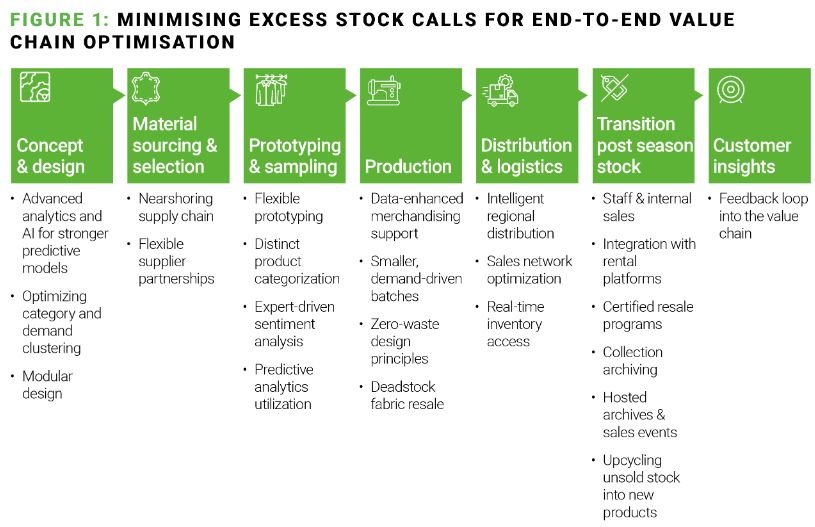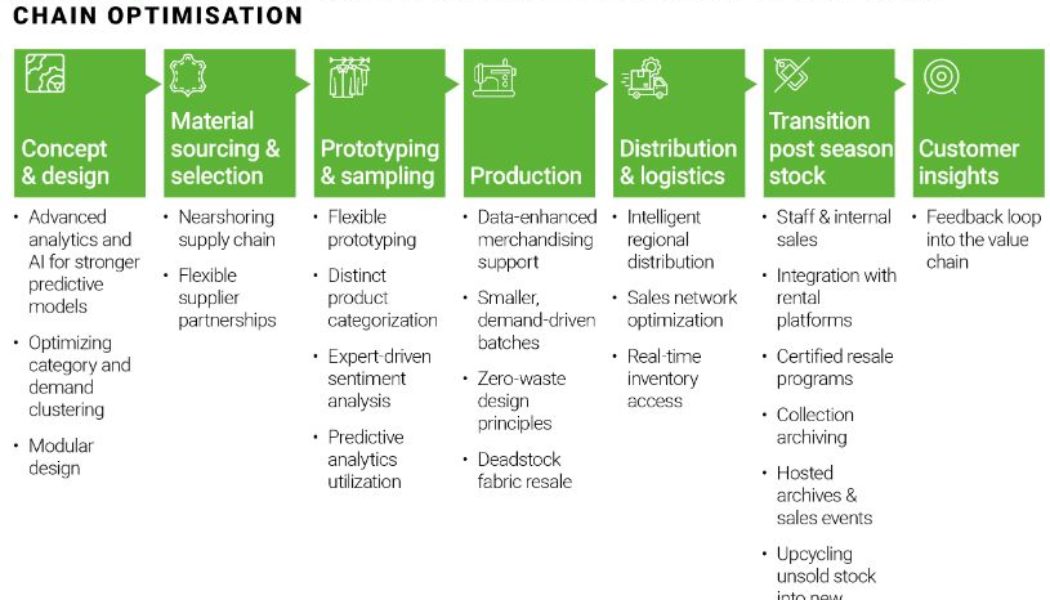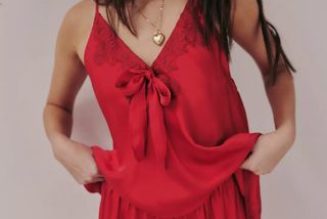The essence of luxury is scarcity.
Luxurybrands face the complex task of amplifying their global
presence and ensuring their collections reach their loyal
clientele, all while carefully balancing the need to avoid
overproduction and preserve the exclusivity that underpins their
brand’s allure.
Excess inventory, typically associated
with fast fashion’s cyclical waste, is a growing concern for
luxury brands. Regulations around the destruction of unsold goods
have changed the calculus for the old model of overstocking to meet
demand, but shedding excess inventory through discounting puts
brand value at risk. Luxury brands face a unique challenge: They
must meticulously balance production with demand and navigate
evolving ethical and regulatory complexities. The Fashion
Transparency Index 2023 found that88% of major fashion brands don’t disclose
their production volumes, but we are seeing companies like
Hermès and LVMH get creative about waste reduction. AI
tools, enhanced network planning, gamification of forecasting, and
small-batch production each have a role in the solution, alongside
other key approaches.
Luxury brands must, therefore, introspect
and innovate to sustainably address surplus inventory without
compromising brand positioning.
Excess inventory wasn’t
always a problem
In luxury fashion, it has historically
been more profitable to produce in excess rather than face a
shortage, as missing out on full-priced sales can have a
substantial negative impact. High product margins cushion this
approach, which is also reinforced by the economics of luxury
branding and marketing investments—costs associated with
upholding brand prestige and market position exceeding the profits
companies could make from liquidating excess stock in the long
run.
With tightening regulations, especially
the European Union’sfirmstance against destroying unsold goods,
and evolving consumer awareness signaling a pressing need for
change, luxury brands are increasingly compelled to reconsider
their strategies, pairing the industry’s storied exclusivity
with sustainable, economically sound practices.
Eliminating inventory
destruction is a crucial step forward and alternatives are already
within reach.
Efficient production in luxury fashion
hinges on strategically optimizing the end-to-end product value
chain—crafting key strategies to optimize production volumes
through the three phases: pre-production, production, and
post-production.
Pre-production
These strategies begin with precise
category and assortment planning, distinguishing between seasonal
and seasonless items to accurately demand forecast and mitigate
stock excesses.
Tailoring assortment
planning: Brands must adopt a tailored assortment
approach, shifting from a one-size-fits-all model to finely
segmenting their product categories.The risk of obsolescence varies
significantly within a product portfolio, especially for seasonal
items and variations of classic pieces. These items are highly
time-sensitive and prone to rapid shifts from shortage to excess in
the fast-paced fashion cycle. A sophisticated assortment
architecture strategy is crucial for production forecasting,
ensuring production forecasts capture product risks within
categories.
Leveraging precision
AI:Luxury fashion is in an AI revolution to enhance trend
prediction and inventory management. One clear use case leverages
enhanced data analytics for more qualitative insights such as
sentiment analysis, emerging fashion trends, consumer behaviors,
social-media dynamics, and rapid sales data-processing.
This data can then be used to enable
precise demand predictions, guiding brands to make informed
decisions on production volumes down to the most granular
level.
Amplifying salesforce and client
advisor insights:Luxury brands have a goldmine in their
client advisors. Their direct engagement with clientele offers
real-time insights into preferences and trends. These frontline
insights can also be used to refine production plans and align
forecasts with predicted consumer demand.
Companies can capitalize on this
knowledge by integrating gamification into the forecasting process.
With an intuitive digital platform, luxury brands can empower their
staff to input sales predictions, market insights, and inventory
recommendations. The platform could reward accuracy with points or
perks, fostering a competitive yet collaborative environment that
motivates front-line staff to share precise and actionable data,
transforming their observations into a strategic tool for enhancing
inventory precision.

During-production
After the essential groundwork paves the
way for a tailored production, critical inputs can match
up-to-the-minute market demand.
Adopting smaller batches and
on-demand production: By adopting smaller batch production
and on-demand manufacturing, luxury brands can more precisely meet
real-time consumer demand, minimizing overproduction and surplus
stock. Integrating virtual sampling is crucial, facilitating
digital prototypes that expedite the design phase, trim time to
market, and curtail waste. Such shifts demand a flexible supply
chain, supported by strong predictive analytics and nimble
suppliers, to quickly adapt to changing demands.
AI tools can also integrate real-time
data analytics to adjust production schedules, optimize supply
chains, and even tailor marketing campaigns to anticipated consumer
trends, ensuring optimal product availability.
Designing for zero
waste: From the initial design to the atelier’s floor,
embracing zero-waste principles ensures maximum material
utilization, marrying artisanal craftsmanship with sustainability
to reduce pre-consumer textile waste. Innovations like AI-powered
design software can revolutionize material use, particularly in
zero-waste pattern cutting, embedding sustainability into the
manufacturing process.
Instilling creative repurposing,
aka “scrap couture”: Integrating scrap fabrics
into luxury collections, the innovative concept of scrap couture
offers an avant-garde blend of sustainability and high fashion.
This approach challenges designers to creatively repurpose surplus
materials, transforming them into unique, luxurious pieces that
resonate with eco-conscious consumers.
Showcasing these upcycled masterpieces in
prestigious runway shows makes a powerful statement, elevating the
brand’s status while spotlighting its commitment to innovation
and sustainability. It also provides an opportunity to elevate
brand positioning and showcase design capabilities.
A prime example of this practice in
action isHermès’Petit h Studio. Celebrated as
a creative atelier within the esteemed luxury house, Petit h
breathes new life into scrap materials and leftovers, ingeniously
repurposing them into fashionable and home accessories.
Solving for sustainable raw material deadstock:
The resale of high-end deadstock fabrics is emerging as a
sustainable and economically viable avenue for managing excess raw
material. One notable enterprise leading this initiative is the
LVMH-backedNona Source, which capitalizes on repurposing
excess high-quality materials and providing creatives and emerging
designers with access to high-end circular materials from top
luxury houses and reports that it has upcycled up to 100 tons of
textile since creation.
Platforms such as these cater to diverse
needs, offering exclusive trims, leather offcuts, and specialized
fabrics. They broaden emerging designers’ resource pool and
present a sustainable solution to managing surplus raw
materials.
Post-production
This phase zeroes in on the crucial
elements of strategic supply chain planning and agile inventory
management to meet seasonal demand efficiently, ensuring products
reach customers before the fashion season transitions to a new
collection.
Honing assortment
allocation: Luxury brands must utilize in-depth market
insights to tailor product assortments to regional preferences,
strategically navigating the dynamics between trendsetting regions
and trend consumers. This strategy employs a reverse bullwhip
effect to streamline production and meet market demand
efficiently.
Timing and distribution agility are
particularly critical for seasonal wear, requiring swift product
delivery to stores to exploit fleeting market trends and seasonal
demand spikes. Customizing assortments according to regional tastes
is crucial. A strong understanding of diverse market preferences
will enable strategic product variation—in colors and
designs—to ensure alignment with local fashion
sensibilities.
Creating an omnisupply:
To mitigate discrepancies in product availability, efficient
synchronization between demand and supply across retail stores,
wholesale, and omnichannel is vital. Enhanced network planning,
mini depots, and flexible regional logistics strategies are
critical. Integrating a digitized, real-time inventory monitoring
system across channels also optimizes demand.
Charting a sustainable path
ahead
In the fashion and apparel sector, where
the pace of change outstrips nearly every other industry, deploying
state-of-the-art forecasting technologies still falls short of
achieving absolute precision in demand forecasting.
The dynamic nature of consumer
preferences and the rapid turnover of trends render stockouts and
surplus inventories a persistent challenge, notwithstanding the
adoption of pre-order models designed to mitigate these issues.
Thus, the imperative for fashion brands is not merely to minimize
excess stock but to pioneer and adopt sustainable strategies for
inventory management. These strategies must adeptly balance the
imperative of maintaining the brand’s value in the eyes of the
consumer with the necessity of adhering to increasingly stringent
regulatory standards.
Still stuck with excess
inventory? Consider the 3 Rs
Rent:Collaborating with
or establishing rental platforms extends the lifecycle of luxury
items, keeping them in circulation, reducing waste, and aligning
with sustainable consumption trends.
Resale: Developing
certified pre-owned programs or partnering with luxury resale
platforms can ensure the longevity and relevance of luxury items
and support a sustainable, waste-reducing ecosystem.
Re-release: Storing
select collections for future re-release taps into the power of
consumer nostalgia, offering luxury brands an opportunity to
repurpose past inventories while maintaining the allure of
exclusivity and timeless appeal.
The content of this article is intended to provide a general
guide to the subject matter. Specialist advice should be sought
about your specific circumstances.









